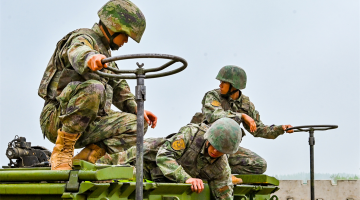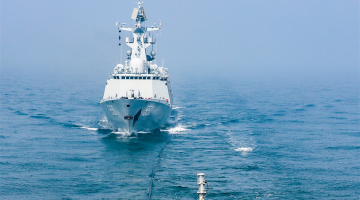
A photo shows the lighthouse on the Nansha Islands' Zhubi Reef in the South China Sea. (Photo: Xinhua)
By Wu Shicun
The Nimitz and Reagan aircraft carrier strike groups of the US Navy are carrying out military exercises in the South China Sea right now. This is the first such drill in recent years. The US military even publicly declared this to be the most significant symbol of its determination.
The year 2020 will witness the situation in the South China Sea shift from "stabilizing" to "turbulent". Specifically, a series of events in the South China Sea since May triggered the increased tense situation in the South China Sea. Worrying new changes are taking place in this region.
Provoking "militarization of the South China Sea"
The COVID-19 pandemic hits the US really hard, and the US military has not been spared. But instead of slowing down its military operations in the South China Sea, the US has intensified its use of the South China Sea issue to contain China.
The US issued the report titled "United States Strategic Approach to the People’s Republic of China" on May 20, threatening to suppress China. The US Mission to the United Nations submitted a diplomatic note to the office of the UN Secretary-General’s office on June 1, objecting China's enjoyment of "historic rights" that exceeds the marine entitlements that China could assert consistent with the United Nations Convention on the Law of the Sea (UNCLOS) in the South China Sea.
It is strange that also on June 1, the Philippine government ordered the suspension of the "Philippines-US Visiting Forces Agreement". The Philippine Defense Minister boarded the Zhongye Island in the South China Sea on June 9. At the same time, the US Navy carried out two rounds of double aircraft carrier exercises in the Philippine Sea on June 21 and 28, respectively.
At the same time, the US did not relax its surveillance and intelligence gathering of Chinese military exercises from the sea and the air. The Independence-class Littoral Combat Ship USS Gabrielle Giffords (LCS-10) carried out operations in the South China Sea for two consecutive days from June 30 to July 1. A US Navy EP-3E electronic reconnaissance aircraft appeared over the Bashi Channel on July 2. If we take into consideration the five "freedom of navigation" operations carried out by the US in the South China Sea since this year, it is not difficult to find that US military operations in the South China Sea are more aggressive and provocative than ever before. The US is the biggest threat to stability in the South China Sea and the biggest black hand that provokes the "militarization of the South China Sea."
Colluding with the US?
The US is neither a coastal country nor a claimant of the South China Sea. If it wants to maintain a military presence therein, intervene in relevant disputes, and use the South China Sea issue to contain China, it cannot plot without the collusion of the countries in the region.
In other words, the provocative and risky actions of the countries in the region against China are either instigated by the US or backed by the US. This can be proved by the "diplomatic note war" triggered by Malaysia's submission of an extended shelf claim in the South China Sea to the UN’s Commission on the Limits of the Continental Shelf (CLCS) at the end of last year, and the unilateral actions of other claimants. Shadows of the US are even looming over the Code of Conduct in the South China Sea (COC) consultations.
The diplomatic notes submitted by the Philippines, Vietnam and Indonesia against Malaysia or China are based on the arbitral award in favor of the Philippines over the South China Sea issue, which denies China's "historic rights" in the South China Sea, the island status of the Nansha Islands and the claims of maritime jurisdiction. At a critical moment of the diplomatic wars of words among various countries, the US suddenly jumped out and intervened. Its note to the UN totally denied China's rights and claims in the South China Sea.
Moreover, other episodes include: the unilateral oil and gas development in the Wan'an Tan area by Vietnam last year, the "ship collision incident" caused by illegal fishing in waters off Xisha Islands in this April, and Vietnam's recent threats to initiate a new South China Sea arbitration against China. Vietnam obviously would not go all out to "fight with China to the end" without US’s support. Similarly, Malaysia's unilateral oil and gas development in the disputed area of Nansha Islands, the expansion of the Philippines' facility on Zhongye Island, and the aggressive law enforcement by Indonesia in the traditional Chinese fishery in Natuna Islands are inseparable from the instigation and public support of the US.
The stability of South China Sea cannot be subverted.
The strategic cooperation between the US and Vietnam, and the alliance relationship between the US and the Philippines have continued to rise. Some claimant countries have used the window period of COC consultations to consolidate and expand vested interests with unilateral actions. The COC consultations stalled due to the pandemic. The resurgence of the arbitration award and its interference with the maritime cooperation in the South China Sea will be the distinctive features of the development and changes in the South China Sea in the future.
As a leading force safeguarding peace and stability in the South China Sea, China will spare no effort to promote the rule-based development of a maritime order in the South China Sea, promote the construction of facilities based on the civilian development of Nansha islands and reefs and the provision of international public goods. China will integrate its maritime powers with the goal of rights protection and stability maintenance in the South China Sea, and build its capabilities to adapt to the future naval warfare style change. China will be devoted to give full play to "the Chinese strength" and "the Chinese presence" and will continue to be the anchor for maintaining peace and stability in the South China Sea.
(The author is President of China’s National Institute for South China Sea Studies and Chairman of Board of Directors of China-Southeast Asia Research Center on the South China Sea)
Disclaimer: This article is originally published on huanqiu.com and translated from Chinese into English and edited by the China Military Online. The information, ideas or opinions appearing in this article do not necessarily reflect the views of eng.chinamil.com.cn.









